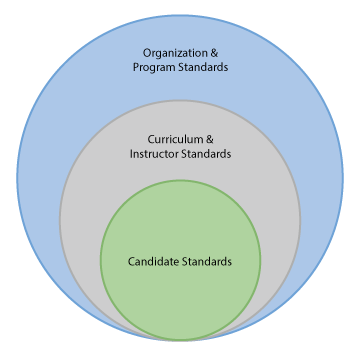Introducing TESOL's Standards for Short-Term TEFL/TESL Certificate Programs
by TESOL International Association
TESOL International Association has a long history of standards development for the field of English language teaching, starting with the first national standards for ESL in the United States published in 1997. In the most recent TESOL Strategic Plan, TESOL’s commitment to advancing the field of English language teaching through quality standards was reemphasized as one the association’s five goals.
Given the diversity of global contexts in which English language teaching takes place, many people starting in the field of teaching English as a second, foreign, or additional language pursue an entry-level credential through various short-term TEFL/TESL (or TESOL or English as an additional language [EAL]) certificate programs (TESOL, 2009a). TESOL’s Standards for Short-Term TEFL/TESL Certificate Programs were created to respond to the proliferation of these certificate programs around the world and to the demand for high quality and accountability in these programs.
Given TESOL’s rich history of standards development in the fields of EFL and ESL, many certificate program administrators, instructors, and students have looked to TESOL to develop these standards. The TESOL board approved the development of short-term TEFL/TESL Certificate Program Standards as well as the creation of the Accreditation Standards Expert Group in 2014.
Scope and Purpose
The Standards for Short-Term TEFL/TESL Certificate Programs are intended for courses of study delivered in English that prepare candidates to teach EFL and ESL to adult, adolescent, or young learners. Whether in a face-to-face, online, or hybrid setting, programs follow a model of interactive instruction as well as an evaluation–feedback process. TESOL research has shown that course hours of short-term certificate programs vary widely among providers, ranging from 20 to 250 hours. These standards are intended for programs that are 120 to 180 interactive hours in length and that include
- instruction in language and culture,
- instruction in TESOL theory and methodology, and
- classroom observation and supervised practice teaching with students who are ELLs.
The Standards for Short-Term TEFL/TESL Certificate Programs are relevant to any short-term certificate TEFL/TESL program regardless of the learning platform (e.g., face-to-face, virtual learning, or hybrid model). However, TESOL understands that programs operating within a virtual learning environment will need both creativity and flexibility in meeting some of the standards (e.g., how the practicum is conducted). Similarly, virtual learning or hybrid programs will need to account for their instructional hours differently than face-to-face programs.
TESOL recognizes that TEFL/TESL short-term certificate programs vary greatly around the world and that each organization must respond to the specific needs of its students and their communities. For this reason, the Standards for Short-Term TEFL/TESL Certificate Programs are built to be prescriptive in areas that are vital to the maintenance of a successful program as well as flexible in some areas to meet the needs of the populations being served. The standards are intended to provide a framework for organizations to use in developing, implementing, and evaluating short-term TEFL/TESL training programs.
Organization of Standards
The Standards for Short-Term TEFL/TESL Certificate Programs are divided into three strands of standards:
- the Organization and Program Management Standards
- the Curriculum and Instructor Standards
- the Candidate Standards
The Organization and Program Management Standards provide guidelines for managing TEFL/TESL certificate programs, including hiring instructors. The Curriculum and Instructor Standards provide guidelines to programs for developing or selecting a curriculum and procedures for providing instruction. The Candidate Standards describe what candidates should know and be able to do upon completing the training program.
The Candidate Standards form the core of the standards in that they represent the ultimate goal of the program, which is to support candidates in becoming ESL/EFL teachers. However, the Organization and Program Management Standards and the Curriculum and Instructor Standards are essential in that they provide an administrative framework for the program. Those two strands of standards ensure that the Candidate Standards are likely to be met and that the candidates receive the instruction and services to reach their goals and the goals of the program. The Organization and Program Management Standards as well as the Curriculum and Instructor Standards also ensure that the Candidate Standards remain relevant and effective over time. Figure 1 illustrates the relationships among the Organization and Program Management Standards, the Curriculum and Instructor Standards, and the Candidate Standards.

Figure 1. Relationship Among Organization and Program Management Standards, Curriculum and Instructor Standards, and Candidate Standards
See an overview of the Standards for Short-Term TEFL/TESL Certificate Programs on TESOL’s website. The standards will be available for purchase on 14 September 2015.
TESOL Blogs
Interested in writing a blog for TESOL?
Contact
Tomiko Breland with your idea or for submission details.
Check out the latest TESOL Blogs:
|
Critical Thinking About Technology: An ELT Activity, by Alexandra Lowe
 Our world is awash in new technology. New electronic gadgets, new smartphone apps, and new forms of social media abound. But which of these will stand the test of time? And how do these dazzling technology innovations compare in significance to those of the past? Our world is awash in new technology. New electronic gadgets, new smartphone apps, and new forms of social media abound. But which of these will stand the test of time? And how do these dazzling technology innovations compare in significance to those of the past?
This was the critical thinking and speaking task that I recently asked my advanced adult ELLs to tackle as a prelude to watching a series of TED Talks and YouTube videos about technological innovations ranging from 3D printing to a windmill build from scrap materials by a 14-year old in Malawi. Read More. |
|
5 Icebreakers for English Interaction, by Kristen Lindahl
 In the United States, it’s that time of year again, when students and teachers excitedly (reluctantly?) return to the classroom after summer vacation. First and foremost, you’ll want to get your students talking to you and to each other! In the United States, it’s that time of year again, when students and teachers excitedly (reluctantly?) return to the classroom after summer vacation. First and foremost, you’ll want to get your students talking to you and to each other!
In the language classroom, interaction provides many benefits. First, interaction may give students the chance to provide each other with comprehensible input, or input that is slightly above the learner’s current level of language acquisition. Slower, simplified speech, repeated vocabulary, and a chance to negotiate meaning may help students better understand English in use. Read More. |
|
5 Ways To Jumpstart Your ELL Class This Year, by Nathan Hall
 Two months ago, we were wrapping up postservice training. Now we’ve either started our preservice training or are counting down our remaining days of vacation. That means we have to get our classrooms ready for new students, and when our students are English language learners, there are some specific things we can do to make the first few months easier for us and for them. Read More. Two months ago, we were wrapping up postservice training. Now we’ve either started our preservice training or are counting down our remaining days of vacation. That means we have to get our classrooms ready for new students, and when our students are English language learners, there are some specific things we can do to make the first few months easier for us and for them. Read More.
|
|
5 Back-to-School Activities Supporting Student Diversity, by Judie Haynes
 In a previous blog, Creating a Welcoming Classroom Environment for Pre-K-5 ELs, I wrote about how teachers can alleviate many fears experienced by English learners (ELs) who are new to the United States by creating a welcoming environment in their classrooms. A nurturing teacher and friendly classmates can greatly help ELs cope with the hurdles they face. In a previous blog, Creating a Welcoming Classroom Environment for Pre-K-5 ELs, I wrote about how teachers can alleviate many fears experienced by English learners (ELs) who are new to the United States by creating a welcoming environment in their classrooms. A nurturing teacher and friendly classmates can greatly help ELs cope with the hurdles they face.
In this blog, I’d like to discuss how to link instruction during the first week of school to ELs’ home language and culture. When ELs see their home cultures and languages being studied in the classroom, their culture is validated, and that helps to develop positive self- esteem. Here are five activities for ELLs during the 1st week of school. Read More. |